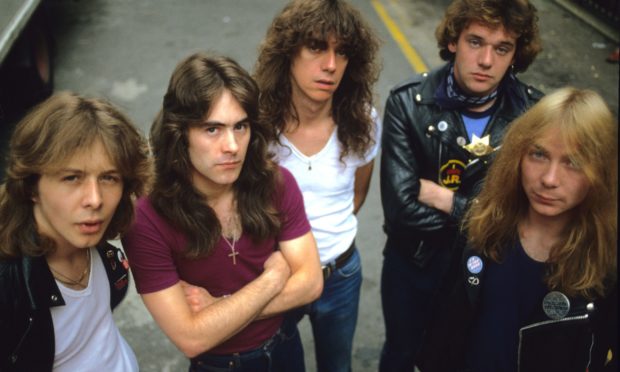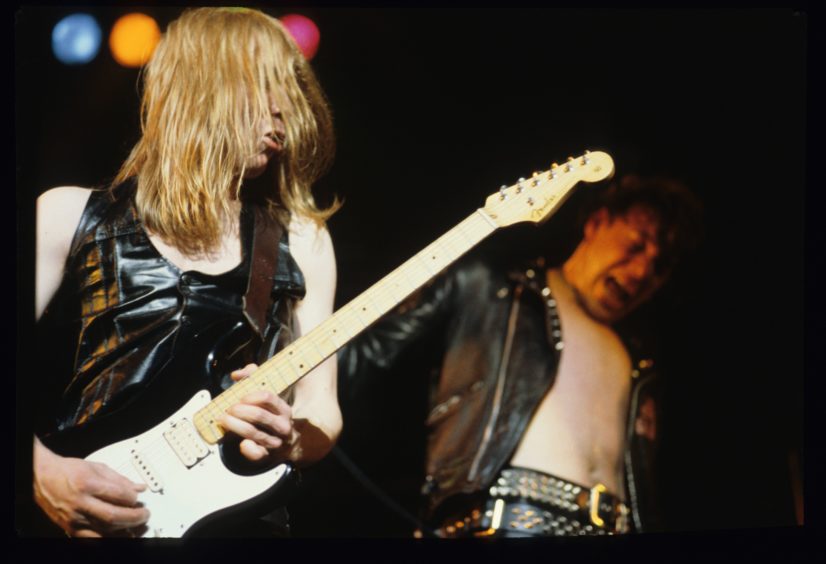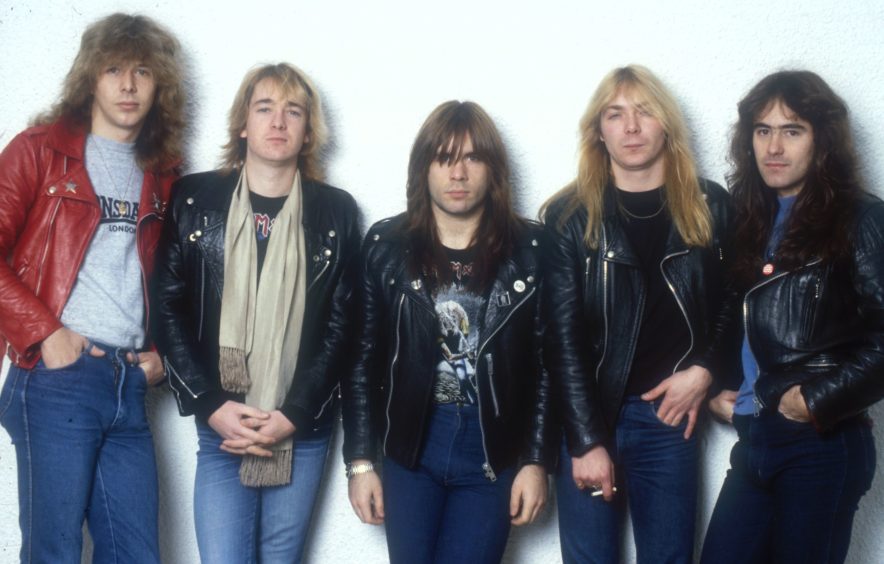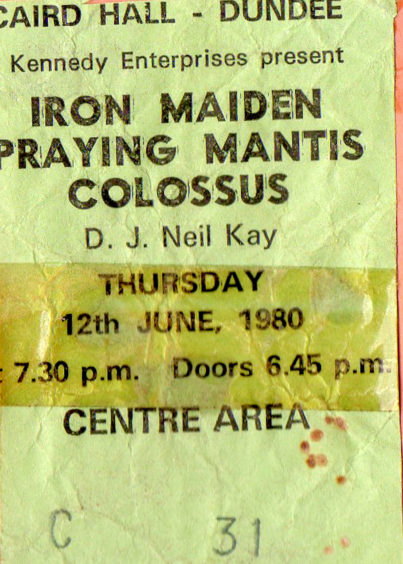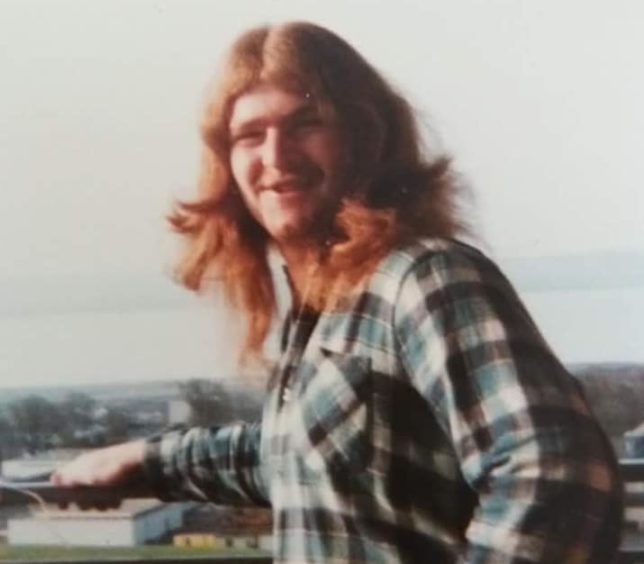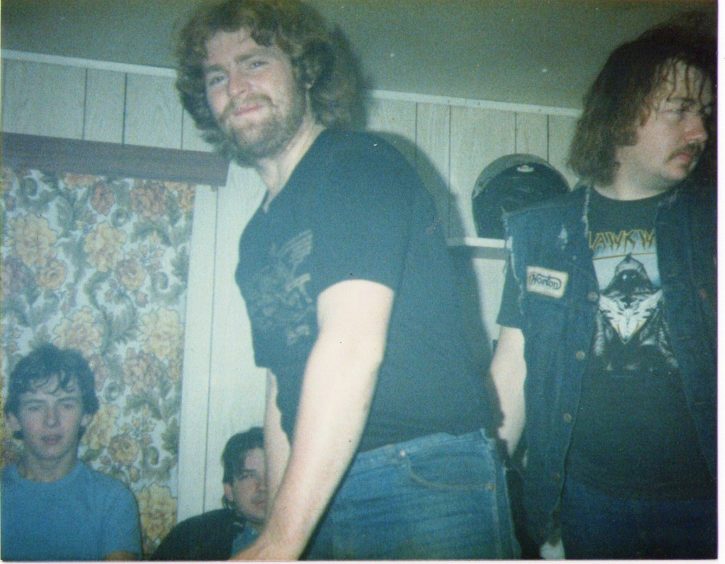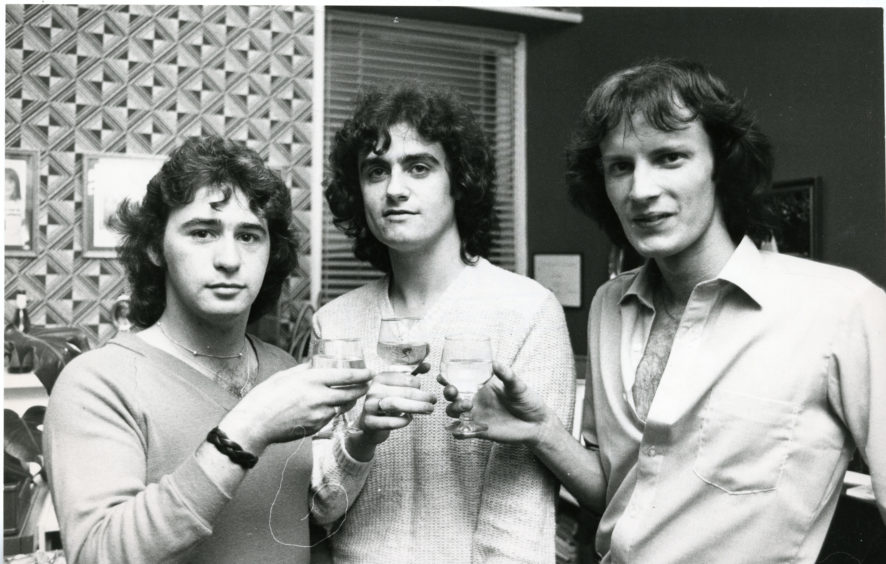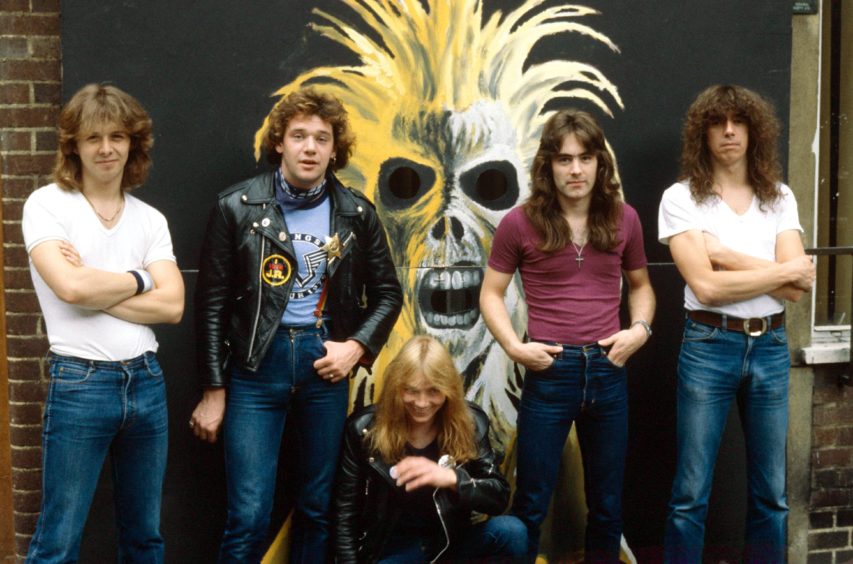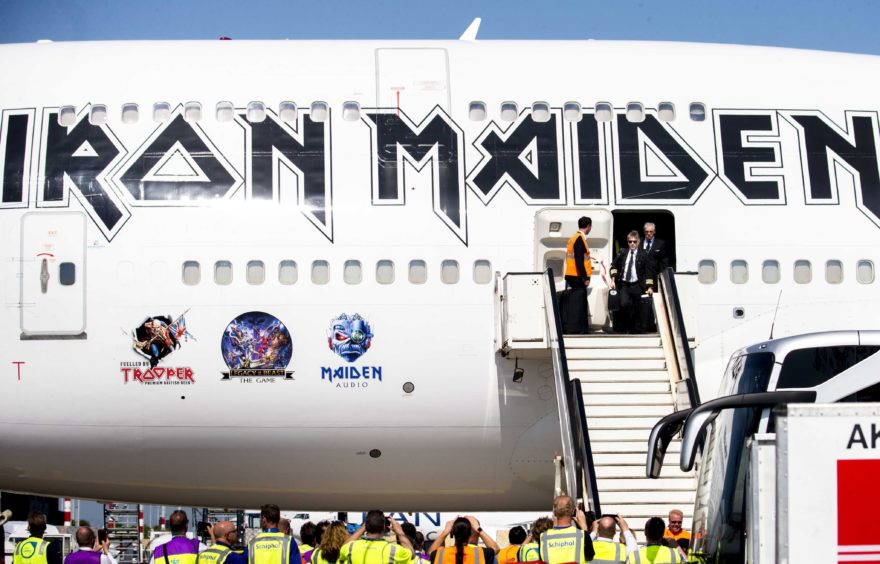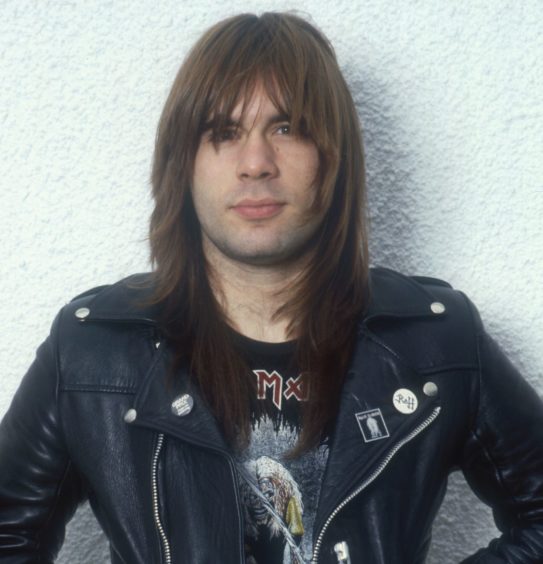Iron Maiden rocked Dundee’s Caird Hall on June 12 1980. Ahead of the gig’s 40th anniversary, Gayle Ritchie looks back at the heavy metal extravaganza and the band’s legacy…
Iron Maiden – heavy metal heroes with a huge catalogue of music who tour the globe in a jet piloted by their lead singer.
That’s the image many people have of the band today, but it was a very different story 45 years ago.
Formed in East London in 1975 by bassist and songwriter Steve Harris, the band was in its infancy.
It didn’t take long for the rockers to win an army of fans and just five years later, in 1980, they staged their first solo headlining tour, The Iron Maiden Tour.
Pioneers of the new wave of British heavy metal, the band achieved initial success in the early 1980s and after several line-up changes, went on to release a series of UK and US platinum and gold albums.
These included 1982’s The Number of the Beast, 1983’s Piece of Mind, 1984’s Powerslave, 1985’s live release Live After Death, 1986’s Somewhere in Time, and 1988’s Seventh Son of a Seventh Son.
Since the return of lead vocalist Bruce Dickinson and guitarist Adrian Smith in 1999, the band have enjoyed a resurgence of popularity, with a glut of new albums and tours.
Their 16th studio album, The Book of Souls, was released in September 2015 and took the top spot in the album charts of 43 countries.
The band had a Legacy of the Beast tour planned for 2020 but this had to be rescheduled to June 2021 due to the coronavirus pandemic.
Maiden in Dundee
The British leg of the Iron Maiden Tour kicked off on April 1 1980 with the band headlining a concert at Dundee’s Caird Hall on June 12.
Support was from fellow heavy metallers Praying Mantis.
Dundee rock band Colossus were also down to play a support slot but a mix-up with the promoters meant they didn’t.
Keeping the crowd happy through the evening was metal DJ Neil Kay.
Original Maiden singer Paul Di’Anno, who fronted the metal legends on their self-titled debut album and its follow up Killers, took to the stage to be greeted with a sea of cheering fans clad in denim and black T-shirts.
The band opened with The Ides of March and finished with I’ve Got the Fire.
“I was there”
Retired sub-editor Steve Taylor described the Caird Hall gig as “out of this world”.
“I wore my jeans, Adidas baseball boots, black T-shirt and Wrangler denim – with all the usual rock band patches on it like Led Zep, UFO, Maiden, Lizzy, Quo, Sabbath, Boston to name just a few,” said Steve, from Dundee.
“I was into hard, head-banging heavy metal at the time and Maiden were on the up. It was hugely exciting.
“I’m pretty sure it was the last time the original singer (Paul Di’Anno) fronted the group before Bruce Dickinson came in and propelled them to stardom.”
Steve loved Maiden’s performance but found Preying Mantis “not that great”.
“That was the last time I saw Maiden but I still remember the gig, 40 years on,” he added.
Colossus
A report in the Evening Telegraph told how hundreds of Dundee rock fans were bitterly disappointed when local band Colossus were taken off the bill at the gig at the last minute.
Colossus, said to be “one of Scotland’s most promising heavy metal outfits”, were at the Caird Hall hours beforehand with their equipment, ready to set up.
The trouble stemmed from a mix-up between the London promoters of the tour and the tour manager responsible for Iron Maiden.
“First signs that the Dundee group were to be axed came when a member of Iron Maiden felt there was inadequate space on the stage for the equipment of three groups,” said the report.
A spokesman for the Caird Hall admitted there were some “crossed lines”.
The gig would have been the first time the band performed publicly with a new vocalist.
Schemers
Maiden’s 1980 Caird Hall gig came about thanks to three working class Dundee lads determined not to get “real jobs”.
The lads, all from the Dundee schemes, brought the rock band to the city – and a film charting the early careers of the fledgling promoters was released last year.
The film, called Schemers, tells the real-life story of the rapid rise of Dave McLean and his friends John and Scot who put on gigs in the city in the 1970s and 80s.
McLean starts out running discos and, after a run in with a local gangster, raises his ambitions to booking major bands such as Simple Minds, U2 and Iron Maiden.
McLean, who is the director, went on to have a hugely successful career in the music business, working with the likes of Nirvana, Rage Against the Machine, Roxy Music, Pearl Jam and Oasis.
“We were the schemers. We were all from the schemes – Fintry, Whitfield – all these places,” he previously told The Courier.
“There were only rubbish jobs going so we thought, we’ll do something different – we need to escape.
“We started various businesses, all crazy sort of things. We did a lot of concerts with up and coming bands.
“We did a lot of gigs in a lot of bars, a lot of clubs. We made a lot of money, (and) lost a lot of money.
“Our biggest gig was here at the Caird Hall with Iron Maiden.”
McLean said he feared the Maiden gig would be a “disaster”, but when he turned up at the venue that night, he was blown away to find more than 1,000 people queued up outside.
“It was a bit of a shambles on the day,” he recalled.
“I had no crew booked, I had no catering booked – they rolled up in two arctic trucks. I had to go and get crews from off the street and my mum made the sandwiches. It was just hilarious.
“I’d sold about 200 tickets in advance, only because we’d done absolutely no promotion.
“We were absolutely useless. And the band had no profile really, but they went to number four that weekend.”
In 2017, the crew behind Schemers invited the people of Dundee to show up at the Caird Hall dressed as “retro rockers” as they needed extras for the movie’s finale, a re-staging of the epic Iron Maiden concert.
With the help of The View frontman Kyle Falconer, who stars in the film, more than 50 locals showed up to take part in the scene.
The film also features Conor Berry, Sean Connor and Grant Robert Keelan.
It was filmed throughout Dundee and premiered at the Edinburgh International Film Festival in June 2019. There were plans to give it a UK-wide cinema release this spring.
It was nominated for the Best UK Feature at the prestigious Raindance Film Festival in London.
Di’Anno to Dickinson
Original Maiden frontman Paul Di’Anno left the band in 1981. He was reportedly fired over his party-heavy lifestyle.
The singer had admitted in the past that he was snorting cocaine “non-stop. 24 hours a day.” He was replaced by Bruce Dickinson in 1981.
Speaking to Metal Hammer magazine in February, Di’Anno said: “I don’t blame them for getting rid of me. Obviously, the band was Steve’s (Harris, bassist) baby, but I wish I’d been able to contribute more. After a while that got me down. In the end I couldn’t give 100% to Maiden anymore and it wasn’t fair to the band, the fans or to myself.”
Dickinson debuted on the band’s 1982 album The Number of the Beast.
He quit Iron Maiden in 1993 (being replaced by Blaze Bayley) to pursue his solo career, which saw him experiment with a wide variety of heavy metal and rock styles.
He rejoined the band in 1999, along with guitarist Adrian Smith, with whom he has released five subsequent studio albums.
Outside music, Dickinson loves to fly planes. He undertook a career as a commercial pilot for Astraeus Airlines, which led to a number of media-reported ventures such as captaining Iron Maiden’s converted charter aeroplane, Ed Force One, during their world tours.
666
Maiden released one of their most popular, controversial and acclaimed albums in 1982 – The Number of the Beast.
The artwork and title track led to Christian groups branding the band members as Satanists, encouraging people to destroy copies of the release.
The band’s manager, Rod Smallwood, claimed Christians initially burnt the records, but later decided to destroy them with hammers through fear of breathing in the melting vinyl’s fumes.
However, the band have always denied they are Satanists.
Bassist Steve Harris said: “It was mad. They completely got the wrong end of the stick. They obviously hadn’t read the lyrics. They just wanted to believe all that rubbish about us being Satanists.”
Harris also stated that The Number of the Beast was inspired by a nightmare he had after watching Damien: Omen II, and was also influenced by Robert Burns’ Tam o’ Shanter.
Plus the band’s drummer, Nicko McBrain, has been a born-again Christian since 1999.
Eddie
For four decades, the band have been supported by their famous mascot, Eddie, who has appeared on almost all of their album and single covers, merchandise (which includes T-shorts, posters and action figures) and live shows.
Originally a papier-mâché mask used in Maiden’s stage backdrop, Eddie also features in the a video game, Ed Hunter, the mobile game, Iron Maiden: Legacy of the Beast, and a pinball game with the same name.
